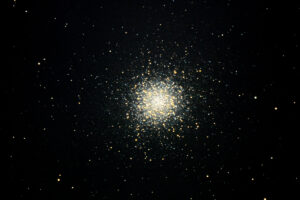Here is last year’s pic with the M13 taken with a 10″ Meade SCT. Exposure was 22 frames at 60 second. It was probably one of the best pictures I got from the Meade.

Because of being able to guide with the 5″ Mak, I was able to get ten 300 second subs to stack (for a total of 50 minutes instead of just 22 minutes). Here is the result.

The magnification of the second image is only about 60% of the older picture, but better focus and guiding give a much higher resolution end product. Funny how a 5″ Maksutkov can outperform a 10″ SCT in astrophotography. Helps lessen the aperture envy problem, too.
To see what I mean, look at the second, more recent picture. Near the bottom of M13 there is a nearly horizontal bar of stars that extends both to the left and right of the main core. Just below this line and just to the right of center just on the inside edge of the core are “two” fairly bright and oblong stars. In the top picture, the same bar of stars is on the left edge and nearly perpendicular. The “two” oblong stars are just to the left and outside the core just below the center. If you enlarge both pictures, you will see that the “two” oblong stars are actually two very close optical doubles.
The two doubles are inside the core using the 5″ Mak because there is more light due to both more total time and more light per pixel on the camera due to a better focal length to pixel size. If you examine enlarged pictures, you will see that the 10″ Meade did give ever so slightly better resolution than the 5″ Mak, but the Mak gave much better resolution than would normally be expected after halving the aperture. I am pretty sure the resolution on the 5″ Mak is enhanced by the guiding.
